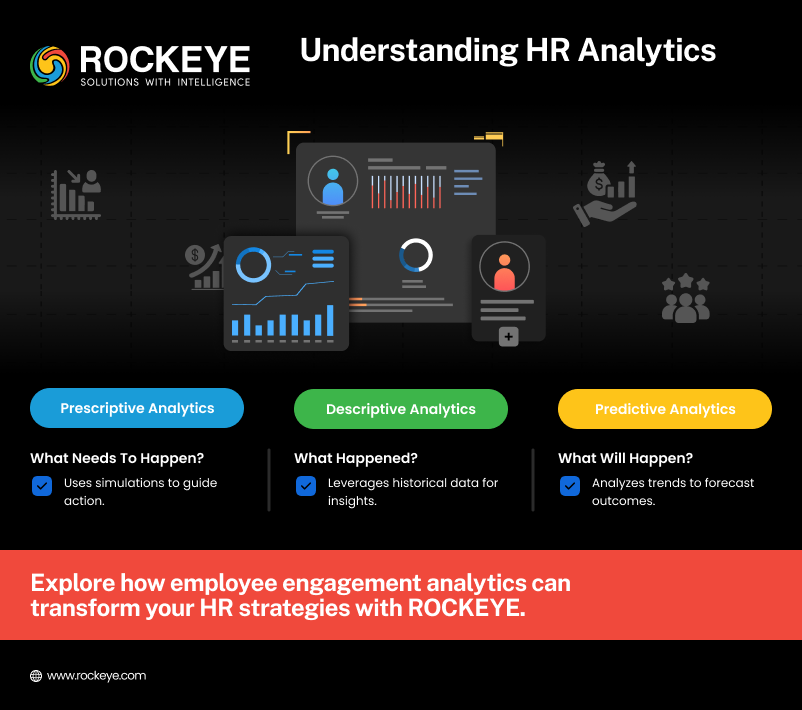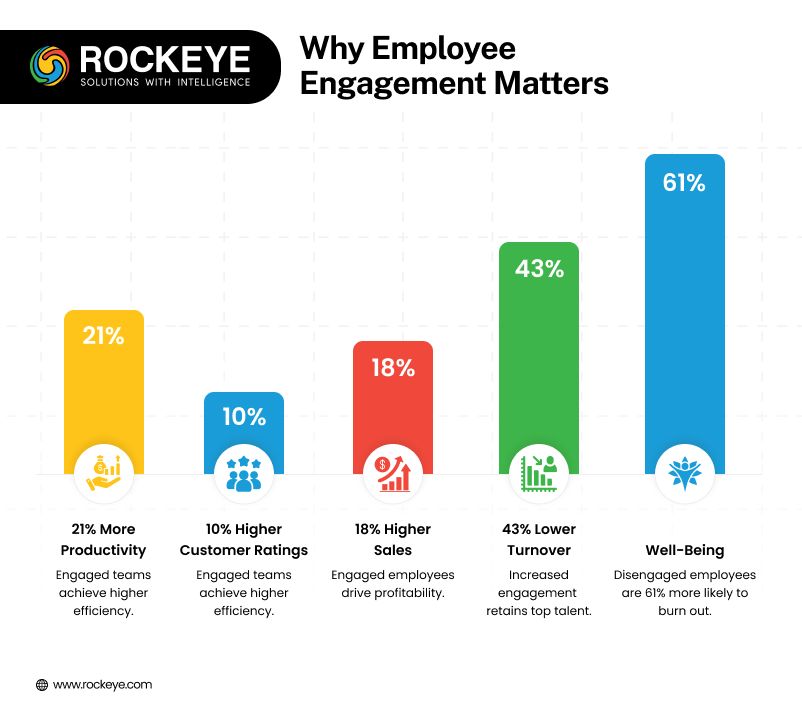Employee engagement analytics is one type of HR analytics that can increase employee satisfaction and productivity.
Key points:
- HR analytics is the collection and interpretation of HR data to support strategic decision-making.
- Employee engagement analytics offer insight into aspects of the employee experience, including productivity, performance, and job satisfaction.
- These insights help HR professionals confidently plan workplace improvements or programs that benefit employees—and the organization’s bottom line.
The source of the 2023 report stating that globally, 77% of employees are either “quiet quitting” or actively disengaged, while only 23% are engaged, is from Gallup’s State of the Global Workplace 2023 report. This report provides insights into employee engagement and workplace trends across the world(Workweek)(Wellable)(Lindauer). None of that is good for business.
To effectively boost employee engagement, retention, productivity, and profitability, it is important to understand workplace engagement trends. By collecting and analyzing employee data consistently and over time, analytics can offer the insight HR needs to make strategic improvements.
What Are HR Analytics?

HR analytics, also sometimes called people analytics or talent analytics, involves gathering and analyzing HR data, and generating reports based on that data. Done well, this will deliver valuable insight to help companies improve in a range of areas, including hiring, retention, training, productivity, and employee engagement, among others.
HR analytics can help organizations identify human resource challenges and help them strategize solutions.
Three Types of Analytics
- Perspective Analytics: This type of analytics asks, “What needs to happen?” and is characterized by techniques such as graph analysis, simulation, or complex event processing to determine an optional course of action.
- Descriptive Analytics: This form of analytics allows us to understand better the changes that have occurred in a business using a range of historical data and benchmarking.
- Predictive Analytics: Predictive analytics answers “What will happen?”. This process uses data and statistical algorithms to identify the likelihood of future outcomes.
Employee engagement analytics
Employee engagement analytics is one type of HR analytics, and a critical one.
At its core, employee engagement refers to the level of connection employees feel to their workplace. Engaged employees are committed, enjoy their work, and are driven to put in the extra effort that helps the company shine. Along these lines, employee engagement analytics focus on areas such as employee satisfaction, productivity, and retention.
This facet of HR analytics can help track how engaged employees are in the workplace, illuminating daily (even hourly) trends, as well as longer-term, big picture ones.
Why Does Employee Engagement Matter?

As mentioned above, engaged employees are more committed to their jobs and invested in their organizations. They understand their work, take satisfaction from it, and do their best.
Engagement thus has several benefits, including:
- Productivity: Highly engaged teams are 21% more productive.
- Profitability: According to Gallup, engaged sales teams receive 10% higher customer ratings (indicating improved customer experiences), 18% higher sales, and a 23% difference in profitability. On the other hand, employees who are not engaged cost businesses an estimated $550 billion a year due to lost productivity, poor performance, and high turnover rates.
- Retention: Engaged employees are more likely to stay in their jobs, reducing turnover rates by 18% to 43%, depending on the industry.
- Well-being: Disengaged employees are 61% more likely to experience burnout and 48% more likely to report daily stress.
- Overall success: 71% of executives say employee engagement is critical to achieving organizational success due to increased innovation, low absenteeism, and other factors.
Also Read: 12 Important HR Metrics That Can Change your Business in 2025
Why Use HR Analytics to Measure Employee Engagement?
Traditionally, measuring employee engagement—like employee happiness or satisfaction levels—was a qualitative or subjective process rather than a quantitative one. Employee engagement insights were usually gathered through surveys or interviews; these are valuable tools, but offer only individual snapshots in time and rarely returning standardized data that can be used to confidently inform business strategy.
Modern HR analytics on employee engagement, on the other hand, gather data across the entire organization over time. An all-in-one HRMS collects and collates information constantly, from every employee.
A sophisticated analysis of this data gives HR professionals an accurate view of who their employees are, who they interact with, what they value, when they perform best, and how effectively they meet performance objectives. The right software can generate insightful reports on trends in everything from absenteeism to collaboration. Employee productivity can be measured to make right choices at the right times, lowering employee turnover rates
Employee engagement analytics offer a solid understanding of the workplace, enabling the HR department to plan improvements and interventions without guesswork.
Key Employee Engagement Metrics to Monitor
HRMS systems that include HR analytics software can provide access to reams of data. From an employee engagement perspective, you may choose to focus on some or all of these metrics:
- Performance and productivity
- Work quality: number of errors, customer reviews, manager feedback, etc.
- Work quantity: sales made, customers served, items created, etc.
- Work efficiency: considering quality and quantity
- Feedback analysis
- Communication trends
- Benchmarks and goals
- Absenteeism
- Retention/turnover rate
- Employee satisfaction: compensation, benefits, workload
Employee engagement is complex. Loyal employees may still experience burnout, for example, or those who feel underpaid may still perform above expectations (while keeping an eye out for another job). For that reason, it’s important to consider more than one metric to gather a full picture of the current state of employee engagement.
How to Use Employment Engagement Metrics
HR analytics, and specifically employment engagement analytics, deliver insight into the overall employee experience. With accessible, clear data, HR professionals can confidently make decisions about how to solve underlying issues—and build on successful workplace initiatives. . Without this information, it can be difficult to make informed decisions
For example, HR analytics reports may encourage HR departments to make improvements to:
- Employee benefits programs
- Compensation packages
- Paid time off allotments
- Available learning opportunities
- Scheduling options
- Remote or hybrid work availabilities
Addressing workplace concerns and boosting engagement helps each employee feel and work better—and that benefits the organization as a whole.
Measuring Data and Analytics
HR analytics can help your business thrive. While gathering data and using it to evaluate workplace engagement can sound daunting, software can make the process intuitive. An all-in-one HRMS like ROCKEYE allows you to manage your HR processes, while also collecting, storing, and analyzing employee data—all in one place.
To learn more about how ROCKEYE can help you make data-driven decisions that improve employee engagement, speak with one of our product experts today.

FAQ
Q1: Why is promptly resolving customer issues after delivery just as crucial as fast shipping?
A: While speedy delivery is a must to satisfy customers, what’s also important is to quickly address their concerns once they receive their order. If they’re not happy with the product, they will request to return it.
Q2: Can you briefly explain reverse logistics and how it differs from forward logistics?
A: In reverse logistics, items move back through the supply chain—from customers to resellers and manufacturers. Reverse logistics not only retrieves the products from customers but also helps recover the value from those returned goods.
Q3: What are the five R’s of reverse logistics?
A: The main elements of the reverse logistics process can be summed up by five R’s: return, replace, repair, resell, and recycle. This sequence starts when a customer requests a return and ends with the decision about whether the product should be resold, repaired, or recycled.
Q4: How can businesses reduce the cost associated with frequent returns?
A: Because returns can be expensive to process, it’s best to minimize them. Selling high-quality products, avoiding misleading ads, and using proper packaging (to prevent transit damage) are effective ways to lower the number of returns.
Q5: When should a replacement be considered instead of a refund?
A: If the product is defective and the customer agrees, sending a replacement can save costs and maintain a good relationship with the buyer. It’s also helpful to schedule pickup and delivery at the same time so the customer can exchange the item in one go.

